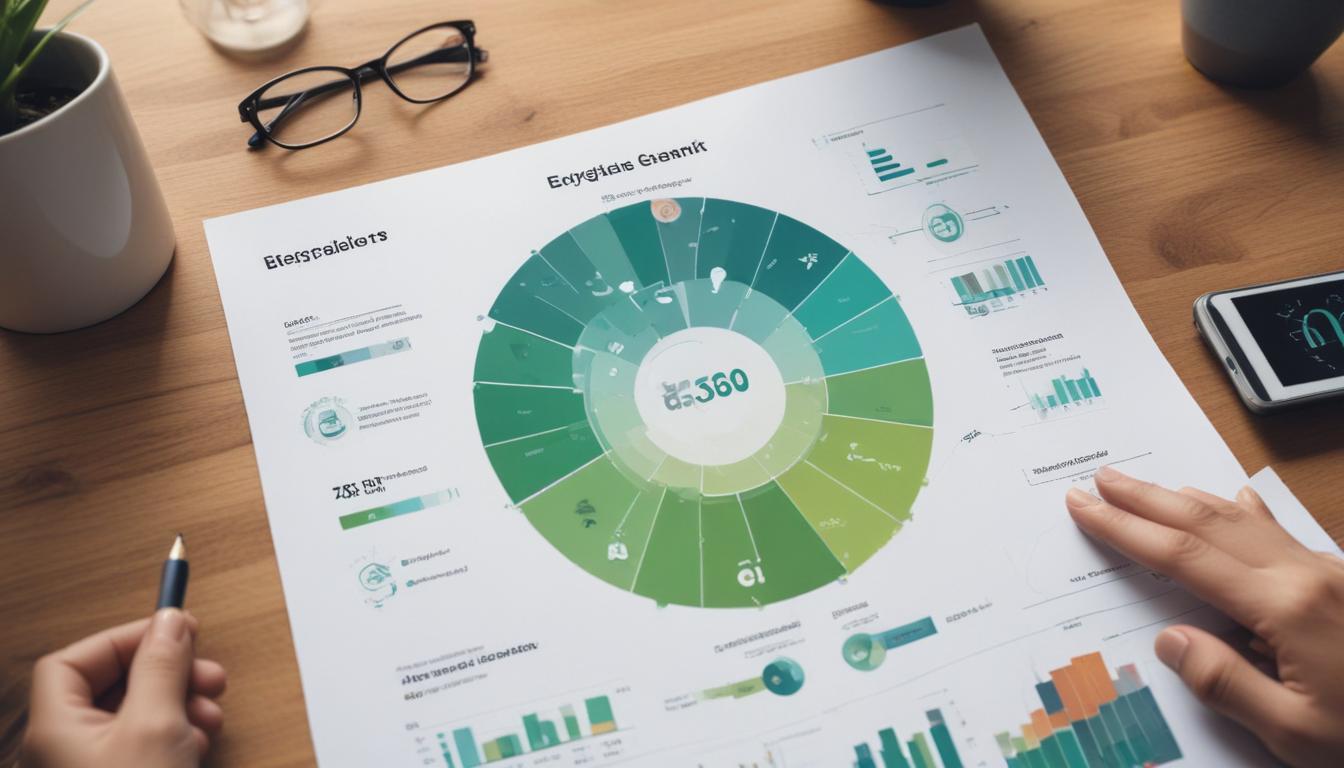ESG benchmarks are critical metrics that evaluate companies based on their environmental, social, and governance practices, guiding investors in identifying sustainable investment opportunities while promoting corporate accountability and transparency.
ESG benchmarks play a crucial role in assessing a company’s sustainability efforts. But how exactly are these benchmarks crafted and applied in the real world? Let’s unravel this important aspect of responsible investing.
Understanding ESG benchmarks: definition and purpose
ESG benchmarks serve as essential tools in measuring corporate sustainability efforts. These benchmarks help investors assess a company’s environmental, social, and governance practices, informing their investment decisions.
A key aspect of ESG benchmarks is their ability to synthesize complex data into understandable metrics. Investors often rely on them to gauge how well a company aligns with sustainable practices. These benchmarks can vary widely, influenced by factors such as industry standards, geographic location, and market expectations.
Here are some typical components of ESG benchmarks:
- Environmental measures: which may include carbon footprint, waste management, and energy efficiency.
- Social parameters: focusing on labor practices, community engagement, and diversity.
- Governance criteria: encompassing board composition, executive pay, and transparency in operations.
- Sector-specific factors: reflecting the unique challenges and opportunities faced by different industries.
Understanding how these components interact can shed light on the overall performance of a company. The development of ESG benchmarks is not static; it evolves as investor priorities shift and societal expectations change.
Furthermore, companies that actively track and report their ESG metrics are often more likely to gain trust and attract investments. This emphasis creates a competitive landscape where transparency and accountability become vital.
The process of determining ESG benchmarks
The process of determining ESG benchmarks is a multifaceted undertaking that involves various stakeholders and methodologies. This process typically begins with the identification of key sustainability metrics relevant to specific industries and regions.
Several steps are crucial in this determination process:
- Data collection: Gathering quantitative and qualitative data from companies regarding their environmental impact, social responsibility, and governance practices.
- Industry analysis: Evaluating industry standards and best practices to ensure benchmarks are relevant and effective.
- Stakeholder engagement: Involving investors, analysts, and other key stakeholders to assess priorities and expectations regarding ESG performance.
- Methodology development: Creating a robust methodology for scoring and ranking companies based on their ESG performance, ensuring transparency and consistency.
- Benchmark validation: Testing and refining benchmarks against real-world performance to ensure they accurately reflect sustainability outcomes.
Each of these steps plays a significant role in developing credible and actionable ESG benchmarks that guide investment and corporate strategy. The landscape is continuously evolving, which requires constant updates in methodologies to keep pace with changing expectations and new sustainability challenges.
Finally, the clarity and accessibility of these benchmarks are vital for fostering trust among investors and ensuring companies remain accountable for their ESG commitments.
Key factors in ESG benchmark development

Developing effective ESG benchmarks relies on several key factors that ensure their relevance, reliability, and utility for investors and stakeholders. Understanding these factors can drive better decision-making in sustainability.
First, consistent data quality is crucial. Accurate and reliable data forms the backbone of ESG assessments. Collecting information from credible sources helps maintain integrity in evaluation.
Second, stakeholder involvement is essential. Engaging various participants, such as investors, analysts, and industry experts, provides diverse perspectives and promotes acceptance of the benchmarks.
Additionally, the context in which the benchmarks operate plays a significant role:
- Industry standards: Different sectors have unique challenges and benchmarks should reflect these variations to ensure appropriate comparisons.
- Regulatory requirements: Compliance with local and international regulations shapes how benchmarks are formulated and updated.
- Market trends: Continuous monitoring of emerging trends in sustainability and corporate responsibility helps refine the benchmarks.
Lastly, a clear methodology for developing and updating benchmarks is necessary to ensure transparency and credibility. By incorporating these factors, ESG benchmarks can better serve as tools for assessing sustainable performance and guiding investment strategies.
Using ESG benchmarks for investment strategies
Using ESG benchmarks for investment strategies has become increasingly significant as more investors recognize the impact of sustainability on financial performance. Integrating these benchmarks allows investors to make informed decisions aligned with their values and risk appetite.
One of the primary advantages of employing ESG benchmarks is the ability to identify companies that lead in sustainable practices. By focusing on businesses that prioritize environmental, social, and governance criteria, investors can reduce risk and potentially enhance returns. Here are several key benefits:
- Risk mitigation: Companies with strong ESG practices are often better managed and less prone to scandals or regulatory issues.
- Long-term performance: Research shows that firms with robust sustainability strategies tend to outperform their peers over time.
- Attracting investment: Investors are increasingly seeking out companies that demonstrate commitment to sustainability, making these firms more attractive in capital markets.
Furthermore, ESG benchmarks can guide portfolio construction and screening processes. They help investors filter out companies that do not align with their values while still providing a diversified investment approach. This alignment not only addresses ethical considerations but also enhances resilience in an ever-changing market landscape.
Impact of ESG benchmarks on corporate behavior
The impact of ESG benchmarks on corporate behavior is profound and multi-dimensional. As investors increasingly focus on sustainability, companies are compelled to adopt practices that align with ESG standards to attract investment and enhance their reputations.
One significant effect of ESG benchmarks is the shift in corporate governance. Organizations are prioritizing transparency and accountability, as they recognize that stakeholders demand greater disclosure regarding their environmental and social impacts. Key changes include:
- Enhanced reporting: Firms are improving their sustainability reporting frameworks to align with ESG criteria, thereby fostering trust with investors.
- Goal setting: Companies establish ambitious sustainability goals to demonstrate commitment to social responsibility, leading to actionable plans for improvement.
- Integrating ESG into strategy: Businesses are increasingly embedding ESG considerations into their overall strategies, influencing decision-making at every level.
Furthermore, the allure of improved performance as indicated by ESG benchmarks drives competition among firms. Companies that excel in sustainability often enjoy better financial performance and reduced risks, which leads to a cycle of positive reinforcement. In short, the influence of ESG benchmarks promotes a culture of responsibility and sustainability, reshaping how companies operate and interact with their communities.
Future trends in ESG benchmarking

The future of ESG benchmarking is poised for significant evolution as sustainability becomes a core factor in investment decisions and corporate strategies. As stakeholders continue to demand greater transparency and accountability, several trends are emerging in the field of ESG benchmarking.
One prominent trend is the integration of technology. Advanced analytics and artificial intelligence are being leveraged to process vast amounts of data, making ESG benchmarks more precise and relevant. This enables companies to receive real-time insights into their sustainability practices.
Moreover, there is a growing emphasis on standardization. Industry stakeholders are collaborating to develop comprehensive frameworks that ensure consistency in how ESG benchmarks are defined and measured. This helps create a universal language for sustainability, fostering better comparisons across sectors.
Additional future trends include:
- Increased regulation: Policymakers are expected to introduce stricter regulations concerning ESG disclosures, pushing companies to enhance reporting practices.
- Focus on social aspects: As social issues gain prominence, benchmarks will likely include more metrics related to diversity, equity, and community impact.
- Climate risk assessment: Companies will increasingly be expected to evaluate and disclose their risks related to climate change, integrating these assessments into their ESG benchmarks.
Collectively, these trends indicate that ESG benchmarking is on a path to becoming more effective, transparent, and impactful, driving real change in corporate behavior and investment strategies.
In summary, the role of ESG benchmarks in the business landscape is undeniable
They serve as essential tools in guiding companies toward greater sustainability and accountability. By understanding how these benchmarks are determined and utilized, investors can make informed decisions that align with their values.
Moreover, the ongoing trends in ESG benchmarking indicate a shift toward integrating technology and standardization, making it easier for businesses to communicate their sustainability efforts. As regulations become stricter, it’s crucial for companies to adapt and prioritize ESG criteria.
Ultimately, embracing ESG principles not only benefits the planet and society but also enhances corporate performance. Companies focusing on sustainability are likely to attract more investors and improve their long-term viability. Therefore, it is essential to recognize the evolving nature of ESG benchmarks and their impact on the future of business.
Frequently Asked Questions
What are ESG benchmarks?
ESG benchmarks are standards used to evaluate a company’s performance in environmental, social, and governance areas. They help investors assess sustainability practices.
How are ESG benchmarks determined?
ESG benchmarks are determined through data collection, industry analysis, stakeholder engagement, and the development of methodologies that reflect sustainability practices.
Why are ESG benchmarks important for investors?
They allow investors to make informed decisions by identifying companies that adhere to strong sustainability practices, potentially leading to better risk management and returns.
What trends are shaping the future of ESG benchmarking?
Future trends include increased use of technology for data analysis, standardization of benchmarks, and a greater emphasis on climate risk assessment and social factors.
How can companies benefit from focusing on ESG criteria?
Companies that prioritize ESG criteria often experience improved reputations, attract more investors, and enhance their long-term financial performance.
What role does regulation play in ESG benchmarking?
Regulations are becoming stricter regarding ESG disclosures, pushing companies to enhance their reporting and transparency, which can positively impact their sustainability practices.


